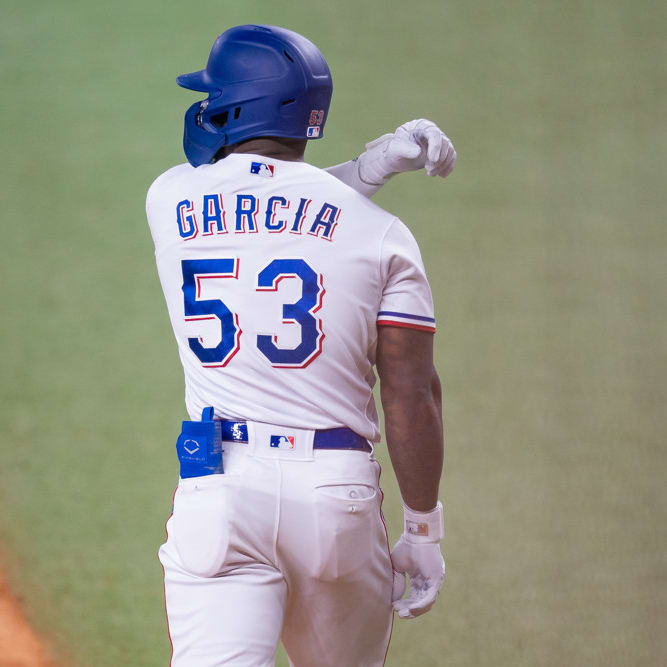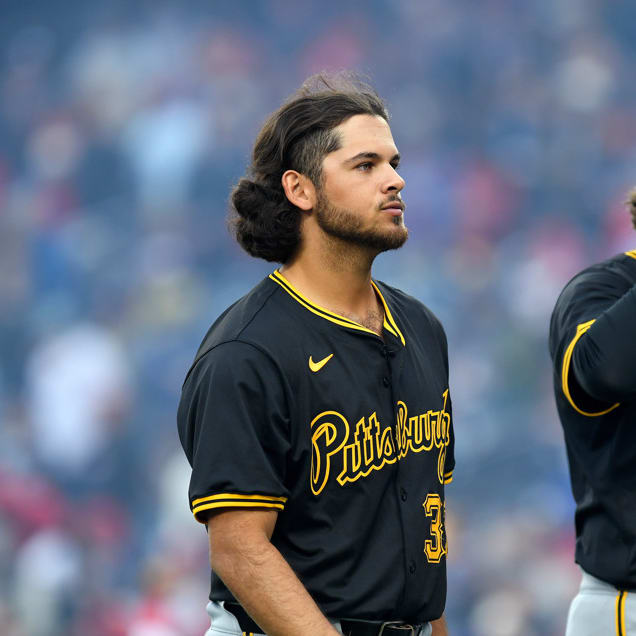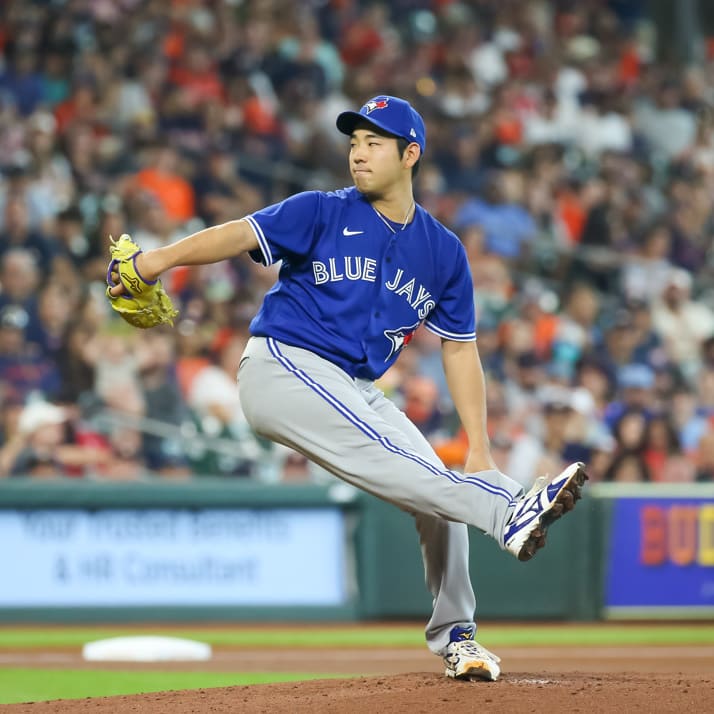This article is part of our Regan's Rumblings series.
Bryce Harper: the New Jack Cust?
From 2007-2009, Jack Cust hit 84 home runs, drew 309 walks and struck out 546 times in 1,717 plate appearance, for a "three true outcomes" percentage of a whopping 54.6 percent. It was a rate several points higher than his contemporaries at the time, the likes of who included one Adam Dunn, Carlos Pena, and whiff master Mark Reynolds. This year, Harper's percentage is a sky-high 65.6. He's homered five times and has an exorbitant 27:20 K:BB in just 90 plate appearances. At this rate, he could draw 150 walks, strike out 190 times and hit 35-40 home runs. Now that rate probably won't continue, but let's take a closer look.
The good news is that his power appears to be back given the trend in his ISO:
2012: .206
2013: .212
2014: .151
2015: .246
His 22.2 BB% is exactly double his career mark, and Harper's 30.0 K% is well above his 21.8-percent career rate. Harper is swinging at fewer pitches outside the strike zone (28.0 vs. career 34.4 percent) while his swinging strike percentage is a career-low 9.5. This all sounds good, but I'm sure the Nationals don't want their franchise player striking out in 30 percent of his plate appearances. I'm not sure what to make of all this, to be
Bryce Harper: the New Jack Cust?
From 2007-2009, Jack Cust hit 84 home runs, drew 309 walks and struck out 546 times in 1,717 plate appearance, for a "three true outcomes" percentage of a whopping 54.6 percent. It was a rate several points higher than his contemporaries at the time, the likes of who included one Adam Dunn, Carlos Pena, and whiff master Mark Reynolds. This year, Harper's percentage is a sky-high 65.6. He's homered five times and has an exorbitant 27:20 K:BB in just 90 plate appearances. At this rate, he could draw 150 walks, strike out 190 times and hit 35-40 home runs. Now that rate probably won't continue, but let's take a closer look.
The good news is that his power appears to be back given the trend in his ISO:
2012: .206
2013: .212
2014: .151
2015: .246
His 22.2 BB% is exactly double his career mark, and Harper's 30.0 K% is well above his 21.8-percent career rate. Harper is swinging at fewer pitches outside the strike zone (28.0 vs. career 34.4 percent) while his swinging strike percentage is a career-low 9.5. This all sounds good, but I'm sure the Nationals don't want their franchise player striking out in 30 percent of his plate appearances. I'm not sure what to make of all this, to be honest. Maybe he just needs to be more aggressive and look to make solid contact rather than try to hit the ball out of the ballpark. I probably need to watch him more, but at this point, I'll just chalk this up to small sample size.
Is this the "Old" Joey Votto?
Through 20 games, Votto is batting an MVP-like .316/.429/.645, and at 31, he appears far from done after a quad injury last year limited him to 62 games of a .799 OPS. Even when his power production started to drop in 2013, Votto still could hit for a high average and draw a lot of walks. His 16.5 BB% and 18.7 K% are in line with his career marks and his BABIP is a reasonable .327, especially considering his career mark is an impressive .358. Look at the power, though, as reflected in his ISO:
2012: .230
2013: .186
2014: 154
2015: .329
Headed into 2015, we figured a healthy Votto was a lock for something in the range of .310/.410/.470, but the power has been a nice surprise. No, 33.3 percent of Votto's May-September flyballs won't clear the wall as they've done so far this month, but after 10.7 percent did last year, perhaps a rate more in line with his 18.6-percent career mark is possible. Doing a bit of quick math and assuming Votto plays 150 games, hits flyballs at his current rate and 18.6 percent go over the wall, he'll finish with 30 home runs at season's end. That's probably a reasonable expectation.
Recommendation Buy Low on Joe Kelly
Kelly has allowed five runs in each of his last two starts to give him a 4.94 ERA this year, but if you dig a bit deeper, there's plenty of reasons to be encouraged:
1.10 WHIP
28.9 K% - Only seven pitchers have a higher number
96-mph average fastball - up 1.3 mph over last year
3.14 xFIP
An improving 3.0 BB/9
Kelly has also shown improvement with his slider, which now ranks as an above-average offering after being well below average last year. The one thing that does concern me is the increase in his FB% from 23.7 to 37.3 percent year over year, though hopefully that is just small sample size related. Still, I love the strikeout rate and the fact that Kelly has bumped his swinging strike rate from 7 to 10.1 percent this year.
What's Up with Alex Wood?
Wood showed a lot of promise last year in 171.2 innings, posting a 2.78 ERA with excellent 8.9 K/9 and 2.4 BB/9. This year his ERA is still solid at 3.00 through four starts, but the ratios? Not so much -- 4.5 K/9, 3.8 BB/9. So what gives? His velocity hasn't changed significantly, he's actually generating more ground balls this year (51.9 percent), and sure, he's throwing more fastballs, but is that it? A 4.2 percent swinging strike rate is incredibly low, as 9.3 percent is just average and Wood had a 9.7-percent mark just last year. Hitters are making contact on a large amount (83 percent vs. a league average of 64.9 percent) of Wood's pitches outside of the zone, perhaps indicating some command issues or simply a need to throw more secondary stuff.
Given that his velocity is stable, it's probably safe to rule out an injury, but it's very odd to see that in his last two starts covering 12.1 innings, Wood struck out just one batter. He might be a good buy low, as the strikeouts should improve, but I'm hesitate to pay based off last year's results.
P.S. Of course, Wood fanned eight Nationals in five innings Wednesday, though he also surrendered five runs.
A Lot of Closers on the Hot Seat
Addison Reed, ARI (next in line: Brad Ziegler) - A .478 BABIP indicates Reed's 2.17 WHIP should drop quickly, but if he continues to give up hits in bunches, a change might be needed. Evan Marshall (6.00 ERA, 2.11 WHIP) seems to be behind Ziegler (0.00 ERA, 0.21 WHIP) on the depth chart.
John Axford, COL (next in line: Rafael Betancourt?) - Barring a trade, whomever the Rockies list as their closer is going to be on the hot seat. Axford could stick in the role for a bit, though, as he has yet to allow a run in his five innings with a fastball averaging an impressive 95.1 mph.
All Dodgers relievers (next in line: all Dodgers relievers) - It's either Yimi Garcia or Chris Hatcher until Kenley Jansen returns from a foot injury in a couple weeks. Paco Rodriguez and J.P. Howell could also factor in, but Garcia (0.84 ERA, 15.2 K/9) is the guy I prefer now.
Tyler Clippard, OAK (next in line: Ryan Cook?) - Clippard is keeping the spot warm for Sean Doolittle (shoulder, late-May ETA), but if Clippard's 1.44 WHIP worsens, he may not last in the role until then. His 7.6 K/9 and 6.5 BB/9 are far cries from last year's 10.5 and 2.9 marks.
Mark Melancon, PIT (next in line: Tony Watson) - Melancon has a 5.79 ERA and 1.50 WHIP in 9.1 innings. He's converted his last three saves to lower his ERA from a lofty 8.53 to its current level, so he probably is safe for now, but another blowup or two and he could lose his job.
Neftali Feliz, TEX (next in line: Shawn Tolleson) - Feliz is off to a rocky start with a 5.00 ERA and 1.78 WHIP with just two saves. A .379 BABIP indicates some bad luck, but the walks are high as well, 9:5 K:BB in 9 IP. Feliz still has his velocity, so he's not in imminent danger of losing his job, but Tolleson is worth a look in AL-only leagues.
Is Lorenzo Cain the Next Michael Brantley?
Cain 2014: 4.8 BB%, 21.5 K%, .110 ISO
Cain 2015: 8.2 BB%, 16.5 K%., .164 ISO
Brantley 2013: 6.5 BB%, 11.0 K%, .112 ISO
Brantley 2014: 7.7 BB%, 8.3 K%, .178 ISO
Brantley as you can see was more of a contact hitter than Cain when he made his leap last year, but the numbers are fairly similar. We could be witnessing a Cain breakout. At .338/.416/.494, he's emerged as a potent leadoff type, but the Royals seem to prefer Alicedes Escobar's .329 OBP in the leadoff spot. Cain hits third, and he's on pace to potentially approach 100 runs, 100 RBI and 30 stolen bases, making him a fantasy monster. The big question is whether he's going to hit too many more than last year's five home runs. He's had as many as 16 in a minor league season, so maybe 12-15 this year is a reasonable target. He's getting the ball in the air more this year, so that's encouraging as well. I don't think he's quite at Brantley's level just yet, but this is also no fluke.
Post-Hype Duds
I'm in a fairly shallow 10-team mixed league where we start 23, have a six-man bench and finish with a 15-man minor league system. Here are a few players on our waiver wire who once showed promise, but who have fallen to the status of waiver-wire fodder:
Will Middlebrooks (3B-SD) - The change in ballparks certainly hasn't helped, but then again, Middlebrooks wasn't hitting in Boston, either. This year, his .222/.259/.395 line is pretty close to what Middlebrooks has done for his career. At least he's cut his strikeout rate from 29.9 to 23.2 percent, and at least with a .173 ISO, his power has somewhat returned. All in all, though, he's NL-only material at best. I don't own him in any leagues, even the very deep ones.
Yonder Alonso (1B-SD) - Alonso is off to a .315/.400/.411 start, but once again, the lack of power is giving him little mixed-league value. The improvement in his contact ability and plate discipline is encouraging, but just four of Alonso's 23 hits have gone for extra bases. Three of those four have come at home, so it's not a function of his ballpark, but more on what happens when Alonso makes contact. He entered Wednesday with a high 66.7 GB%, a metric that is 45.7 percent for his career. Alonso's career HR/FB% is also well below average at 7.5 percent, so at this point there's little here to suggest he's much more than a 10-homer guy.
Colby Rasmus (OF-HOU) - Rasmus hit his fourth homer of the season Wednesday, raising his batting line to .254/.319/.524. The .270 ISO is certainly nice, but Rasmus also entered Wednesday's action sporting a 40.0 K% and .400 BABIP, so the .254 average looks likely to decline, and quickly. He's always had a fair amount of power, but projection at season's end? -- 23 HR, .220 AVG.
Travis Snider (OF-BAL) - Snider has found himself on the bench more often than not lately, as Jimmy Paredes and Delmon Young are seeing time at expense of Snider. Overall, Snider is hitting a decent .275/.362/.412, but that's probably not sustainable given a .371 BABIP. He'll probably get back into the lineup eventually once Young or Paredes cool down, but it's yet another disappointing year so far from the former top prospect.
Brett Lawrie (3B-OAK) - Trust in Billy Beane, right? That's a tough one with Lawrie, as the third baseman is batting just .225/.259/.325. Lawrie sports a 27:2 K:BB in 87 plate appearances, leading to little hope that he's going to be anything more than he's been -- a .230 hitter with 15 home runs.
Kyle Gibson (SP-MIN) - Gibson has only had one really bad start out of four, but with a 4.84 ERA and 1.70 WHIP, it hasn't been a good beginning to the season. Gibson's K:BB is an ugly 6:12 in 22.1 innings, so he's actually been fortunate to have that ERA given his 5.57 FIP. Gibson generates a fair number of ground balls, but he can't get lefties out and simply doesn't miss many bats. Can he change his approach and turn things around at 27? Maybe, but I think he ultimately lands in the bullpen.
Wily Peralta (SP-MIL) - I was pretty high on Peralta coming into the year, after he posted a 3.53 ERA, 7.0 K/9 and 2.8 BB/9 while averaging 95.8 mph on his fastball last year. This year has been different, as he's lost more than two mph and his ratios are 4.3 and 2.2, respectively. The walk rate is encouraging, but the drop in velocity is not. I think he's still plenty good enough to see his 5.04 ERA drop as the season progresses, but an ERA much less than 4.25 the rest of the way seems unlikely.










